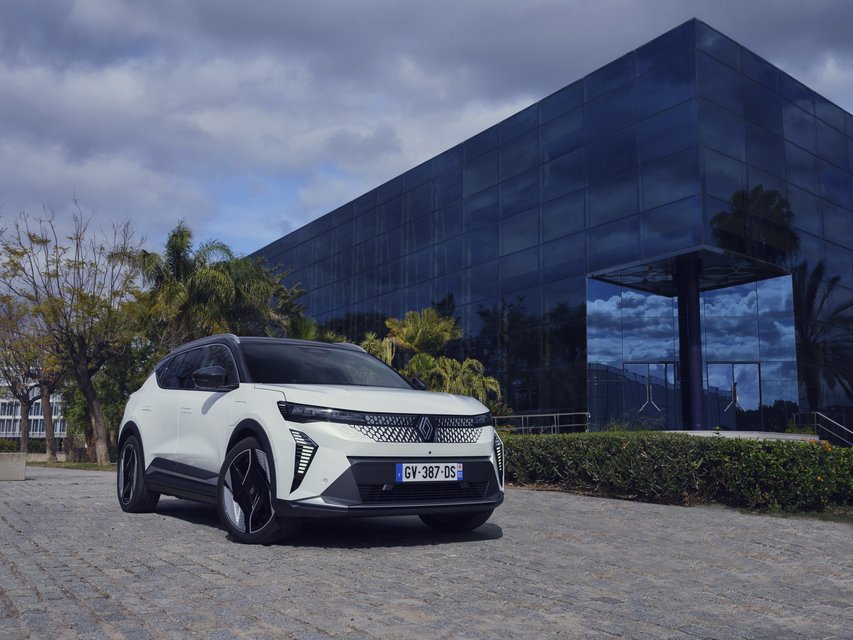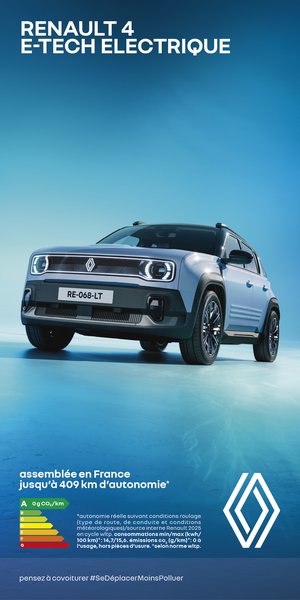
Politique Internationale — Is the development of the electric vehicle (EV) the most important revolution ever faced by a group like Renault?
Luca de Meo — The history of the automobile is punctuated by upheavals that have ushered our industry into new eras. It would take too long to list all the milestones, but some are particularly significant. After the end of the Second World War, globalization was underway: cars were increasingly becoming standard products, and not just reserved for a few regions of the world; national markets were gradually being phased out, while competition was on the rise everywhere. At the crossroads of the 1980s and 1990s, electronics began to spread on a massive scale, with obvious consequences for vehicle design and manufacture. The development of the EV is taking place in an extremely volatile, constantly changing context, whether in terms of energy prices, supply of materials, semiconductors, geopolitical context or regulation. Not forgetting inflation, of course. If I have to use an image, we are on a system of plates that are constantly moving. Under these conditions, it’s impossible to consider the EV world as an isolated entity: wanting to make progress in this field implies solving a large number of problems at the same time.
P. I. — Does this mean that innovation is not the main issue?
L. de M. — More and more electronics are being incorporated into EVs, opening up a whole new world of possibilities. The intelligent car is a tangible reality, a connected object made by both industry specialists and software experts. The opportunity is there to upgrade the car like never before. It’s even more dynamic, as demonstrated by its acceleration capacity. However, I don’t put innovation above all else, for the simple reason that, in the case of EVs, progress requires considerable lead times. Some people dream out loud: they imagine a ten-minute recharge for a range of 10,000 km! It doesn’t work like that: year after year, energy gains for a battery don’t exceed a few percent. It took a decade before we were completely satisfied with the ZOE’s configuration. We’re in a field – electric vehicles – where we’re learning every day, with all the humility that implies. By way of comparison, we’ve been working with internal combustion engines for two hundred years: it’s hardly surprising that a 1.4-liter, four-cylinder, turbocharged engine no longer holds any secrets, to the extent that we continue to optimize it with eloquent results. Let me add a figure: an electric car requires 100 million lines of code, whereas other industrial objects as complex as an airplane require around 20 million lines. We develop high-precision mechanics.
P. I. — What are the main thrusts of Renault’s electric vehicle strategy?
L. de M. — When I took over the helm of Renault Group four and a half years ago, there was a huge amount of work to be done, with many areas of activity requiring a turnaround. But there were also some high-performance segments, such as electric vehicles, where the Group had already taken positions in 2010, notably through its collaboration with Nissan. The teams shone with their skills. Software was also at the cutting edge, although this was more a matter of circumstance – after the Group bought out teams from Intel (the world’s second-largest semiconductor manufacturer - editor’s note). In short, we had a good base from which to work, even if after 2014 the obstacles in the way of electric vehicles led us to take our foot off the accelerator. Today, it’s quite the opposite: put bluntly, we’re pulling out all the stops, with ambitious goals clearly assigned; namely, to switch definitively the electric universe, following the example of Tesla. This dynamic is all the more stimulating since it gives a new raison d’être to our operations in France. Some of our factories in France, such as Douai (Nord), Dieppe (Seine-Maritime) and Maubeuge (Nord), are already spearheads in the electric sector, synonymous with high added value. I’m not forgetting the Group’s shareholders either: because they are convinced of the potential of electric vehicles, they are an invaluable stimulus.
P. I. — There’s also the regulatory horizon: the European Parliament has set a target of 2035, with the injunction to sell only vehicles with zero CO2 emissions. Isn’t this the best strategic lever?
L. de M. — The European authorities are there to set objectives. However, when it comes to the means of achieving them, with the creative process that this requires, the same industrialists must have a free hand. In this case, we at Renault intend to move forward on two fronts. Electricity is one of these pillars, the other being new- generation hybrid and internal combustion engines that guarantee low emissions. In this second area, we have created a company called Horse specifically for this purpose. As you can see, there’s no question of undermining a number of achievements that fall within the orbit of technological neutrality (when different solutions work towards the same goal, in this case carbon neutrality). To name but two, biofuels and hydrogen are two fields already widely integrated into our industry, at the service of increasingly CO2-efficient motorizations.
P. I. — The 2035 horizon is a false good idea...
L. de M. — Let’s just say that an agenda like this requires to introduce a correction mechanism. Programming a strategy over ten years, as is often the case with industrial companies, doesn’t mean that the plan is set in stone. On the contrary, the main objectives are often reconsidered in the medium term, within three to five years. At the same time, depending on how budgets evolve, the major groups examine their trajectory in detail every year. In the electrical sector, as I said, so many factors come into play that we can’t close the door to a series of hypotheses about the way work will proceed. The predominance of China often comes up in conversation when we talk about the imperatives of a timetable: except that the Chinese started out in the electric sector ten years before the Europeans. We can’t close the gap by rushing ahead. After all, there is a real market for EVs in Europe, particularly in the city car and light commercial vehicle segments.
P. I. — Renault has decided to group all its electric developments within the Ampere subsidiary. What justified this decision? With a little hindsight, has it proved a success?
L. de M. — Ampere is not a subsidiary in the strict sense of the term. It’s an independent entity, with its own governing bodies, its own management, its own strategy and the means to implement it. As we wanted to intensify our development in the electrical sector, this choice seemed perfectly natural. The analogy with sports is clear: if you do nothing but padel every day of the week, you’re better off than if you play padel in the morning and tennis in the afternoon. At Ampere, 10,000 people are exclusively dedicated to padel: 10,000 compared with the Group’s total workforce of 120,000. That gives a measure of our commitment to a new activity, and an operation on this scale is not commonplace in large-scale industry. This does not prevent synergies with Renault: for example, for rear-view mirror or sunroof materials, Ampere relies on the Group, since this is not its core business. On the other hand, when it comes to electric vehicles, Ampere alone is in charge.
In terms of financial strategy, the choice of autonomy for our electric development prompted us to consider opportunities for a stock market listing. On the one hand, Renault had the means to launch its development; on the other, we saw no immediate interest for shareholders. Did our approach prove successful? Generally speaking, it takes almost five years to develop a new model. The Twingo will be developed by Ampere in just two years. It’s proof that our decision was the best one, and that everyone was in tune with it.
P. I. — You mentioned the importance of plants like Douai, Dieppe and Maubeuge in driving the push into electric arena. Does this mean resizing the Group’s industrial facilities?
L. de M. — Take a plant like Douai. In 2021, it was equipped to produce around 300,000 vehicles a year. Then it was transformed, on a more compact site, to make the plant more efficient. The electric cadence is creating a new dynamic for this plant as for the others, with repercussions for the entire region. And we’ve redesigned our industrial facilities with this in mind. By way of illustration, Ampere and its range of partners – all grouped within a 300 km radius – represent some 20 billion euros of investment for the Hauts-de- France region. This just goes to show how much the electrical sector is helping to revitalize part of the country.
P. I. — In terms of skills, is the acceleration in the electrical sector leading you diversify recruitment?
L. de M. — The software expertise we need means we have to equip ourselves with the necessary skills. Generally speaking, however, VE does not require us to make any major changes to our traditional workflows. There’s a good reason for this: our training tools are sharp enough to enable us to adapt internally. The ReKnow University, in particular, is working beyond our expectations: while we had set ourselves an initial target of 15,000 people likely to benefit from it, we have already reached 37,000. This increase in skills is a reflection of our other efforts: we’re not playing small.
P. I. — Four main markets are set to support the development of electric power: the United States, China, Europe and the BRICS (Brazil, Russia, India, China and South Africa). To what extent are positions fixed in each of these areas?
L. de M. — Precisely, they are not set in stone. Let’s take the case of the United States: the year 2025 coincides with the arrival of a new administration, whose economic and industrial decisions will be interesting to follow. As for China, its breakthrough is also accompanied by questions, which we’ll come back to later. As for the European Union (EU), the situation varies greatly from country to country. In Italy, for example, electric vehicles account for no more than 4% of new registrations, while in Belgium they already account for 25%. In other words, while the 2035 target may be achievable for one country, it is already impossible for another, even though Italy is a great industrial nation. This brings us back to the principle of correction, which should also apply to the EU: in concrete terms, if we are not capable of correcting this or that aspect of the electric strategy decided in Brussels, Europe will find it difficult to present a united front in the face of major commercial offensives from abroad. Bearing in mind that the automotive and electric sectors in particular involve a huge number of sectors working together.
P. I. — To hear you tell it, the automotive industry isn’t being listened to enough...
L. de M. — That’s the case. I’m not disputing the role that tech and bio-tech can play in public debate, nor do I want to get into sociological or even philosophical discussions about the car, synonymous par excellence with freedom. I’d rather focus on a few figures: the automotive industry in the EU accounts for 8% of GDP, 400 billion euros in tax revenues, and 30% of research and development budgets. We’re one of the continent’s most structurally important industries, which means we need to pay more attention. And speaking of Renault, we produce between 12,000 and 15,000 vehicles every day thanks to a network of twenty plants.
P. I. — China’s rise to prominence in the EV market is arousing both admiration and fear of an unprecedented commercial offensive. What is your predominant feeling?
L. de M. — As I said, China took up this challenge ten years before Europe. The results are indeed impressive: not only is the EV market growing fast, but production is of excellent quality, with high-performance products. Fear? No, certainly not. For one thing, we’re not in awe of the Chinese model. I don’t think the current effervescence in that country is set to last for years: faced with the large number of Chinese manufacturers, the concentration movement will sooner or later claim its victims. On the other hand, I have confidence in Europe’s ability to take significant positions, provided dialogue is established. I insist on this quality of dialogue: in China, we see that when public authorities, companies and the regulator sit down around the table, they very quickly have the will to be constructive and not lose themselves in untimely quarrels. I’m hearing a certain amount of talk in Europe: EVs are too expensive, there aren’t enough recharging infrastructures, motorists aren’t convinced enough... If everyone pulls in the same direction, we’re on the cusp of a profoundly virtuous revolution, which will directly benefit the consumer.
P. I. — So European industry is capable of offering a solid alternative to China...
L. de M. — Let’s remember, even if the phenomenon is little dated: at the time of the Japanese industry’s rise to power, we were already wondering whether Europe would be able to withstand the shock. It’s true that Japanese cars have taken market share, but the major manufacturers, led by Renault, have held up well by exploiting new growth drivers. Finally, the EV should not be seen solely in terms of a trade war: in this field, we are working with many partners, including Chinese ones. The EV is a global solution, all the more promising for its ability to capitalize on synergies.



















